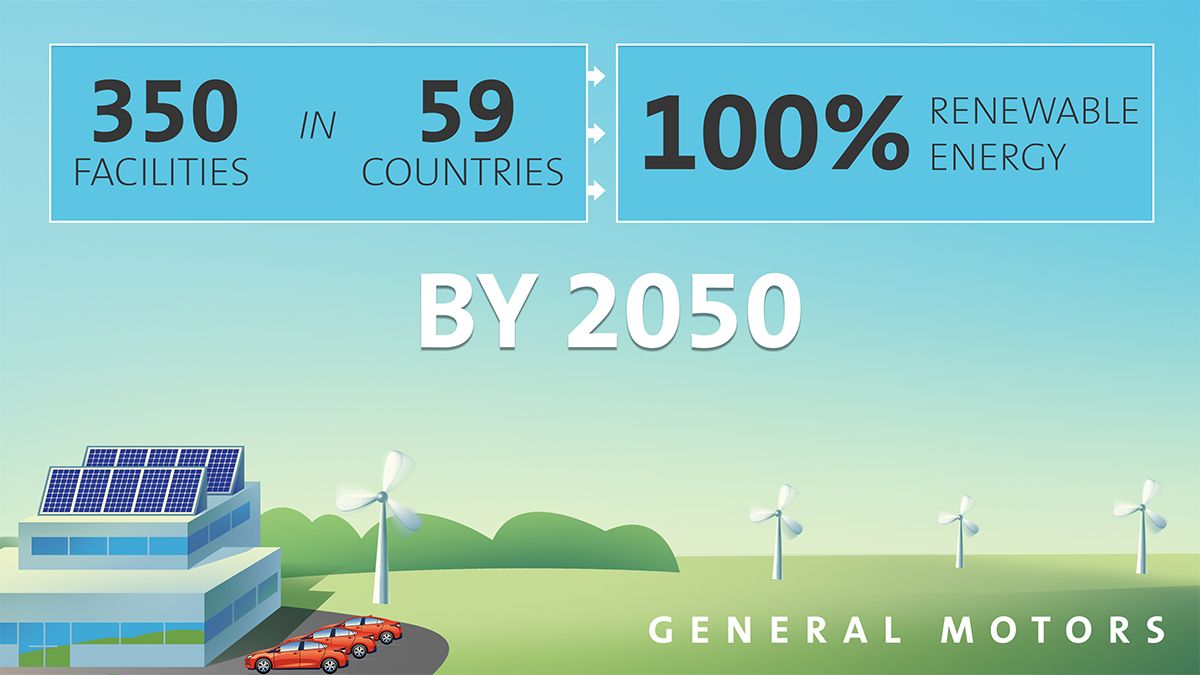General Motors has pledged to use electricity produced entirely from renewable energy sources by 2050. The announcement comes in response to growing calls to become more sensitive to state of the environment. As part of its commitment to reaching its goal, GM also signed up to join the RE100, a collaborative, global initiative of influential businesses that are committed to using 100 percent renewable electricity, working to increase the demand for renewable energy. Included in the organization are some heavy-hitters from other business sectors, including Coca-Cola, Google, Bloomberg, Nike, and a familiar face in the auto industry, BMW.
A big part of General Motors’ plan is to completely use renewable energy, including wind, sun, and landfill gas, in powering its 350 operations in 59 countries all over the world. Considering that the automaker’s timetable is still 34 years from now, it’s hard to imagine what the auto industry is going to look like, let alone what the regulations are going to be in that time. If anything, GM is giving itself plenty of time to make the transition, although with the years it still has to reach that goal, there’s no telling what the automaker is transitioning itself into.
To be fair, the automaker has made some positive gains in getting to its goal. A GM PR representative recently told Autoblog that 3.8 percent of the automaker’s electricity will come from renewable energy. That already includes saving around $5 million a year from using renewable energy as part of a previous goal to promote the use of 125 megawatts of renewable energy by 2020. The automaker’s two new wind projects, which are expected to open later this year, would also help accomplish that 2020 goal as they are being prepared to help power four of the automaker’s manufacturing operations.
Continue after the jump to read the full story.
Give credit where it’s due
It’s admirable to see General Motors take this step, especially when you consider how much the auto industry relies on electricity in the production of the vehicles and the powering of its offices, tech centers, warehouses, and dealerships. Being able to completely use renewable energy to power all of those things is a huge benefit to the environment.
It’s also worth noting that GM’s commitment isn’t just a long term one. On the short term, the company is already making significant steps in achieving its 2020 and 2050 goals. Take a look at what it’s doing to its facilities in China for example. The Jinquai Cadillac production facility, for example, is on pace to use 10 megawatts of rooftop solar power and 20 megawatts of solar carports. The latter will cover 8,100 parking spaces in the company’s own vehicle distribution center parking lot in Wuhan, China.
Look at the automaker’s past and you’ll also notice a trend that points to the GM’s commitment to using renewable energy. The automaker has saved $80 million because of its pioneer status and today, it has 22 facilities with solar arrays, three sites that use landfill gas, and four facilities that will soon be powered by wind energy.
It’s easy to see the 2050 goal and scoff at how long that it is and how far GM still has to go to meeting that goal. Personally, I think it’s unfair to look at that and not recognize what the automaker has already done. It may still have a long way to go, but based on the company’s history, it’s not like the automaker is sitting idle as the rest of the industry, or other industries for that matter, passes it by.

